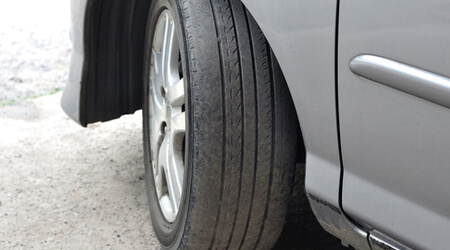
How old are the tires on your car? How old are the replacement tires you purchased on sale at your local tire center? Knowing the answers could save your life, or your family’s lives.
As a tire ages, the rubber begins to break down and crack, both outside and inside the tire. These cracks can cause the steel belts in the tread to separate from the rest of the tire. Higher quality or higher mileage rated tires may age more slowly than other tires, but nothing can stop this process. Various factors including heat, storage and conditions of use also affect how quickly a tire “ages.”
NHTSA research has found that tires age more quickly in warmer climates, and even more quickly when constantly exposed to sunlight and coastal climates. This obviously applies to an extremely hot and humid South Carolina, especially along the low country and coastal areas. Storage also affects the condition of the tire. A tire stored in the trunk is sitting in a miniature oven all summer long. Tires stored on the rear or under a vehicle are exposed to the elements, and tire covers slow, but do not stop, deterioration. The way a tire is used also can drastically affect its condition. Is the tire properly inflated? Has the tire collided with curbs, or other roadside obstacles, such as potholes, speed bumps or debris in the roadway?
It is important to remember that the vehicle manufacturer, not the tire manufacturer, determines the correct tire pressure for tires on your vehicle. The correct pressure is calculated based on the specific vehicle’s “design load limit”, the greatest amount that the vehicle can safely carry based on the correct tire size. The correct pressure information is contained, not on the tire, but on a permanent placard located in the vehicle, usually on the door edge, glove box door, or inside the trunk lid. It also will be contained in the owner’s manual.
Many studies now recommend that tires be replaced no later than six years after manufacture, regardless of the amount of use. You can determine when a tire was manufactured by examining the code stamped into the sidewall of the tire. Tires manufactured after 2000 have a six digit DOT (Department of Transportation) code on the side of the tire. The code begins “DOT”, the next two numbers indicate the plant where the tire was manufactured, the next four numbers indicate the week and year the tire was manufactured. For example, a code of “3112” would indicate that the tire was manufactured in the 31st week of 2012.
With everyone trying to be cost conscious, it can be difficult to replace tires that look ‘new’ or have ‘good tread’. It is impossible to tell the condition of a tire or whether the tire is safe for use from a simple visual inspection. Keep in mind, it is much cheaper to replace a tire, or set of tires, than a car or a family member.
If you or a family member have a claim for injuries or death which may have been caused by a defective tire or outdated tire, please contact the Joye Law Firm. We will answer your calls 24/7 and will discuss your potential claim at no cost to you.

































